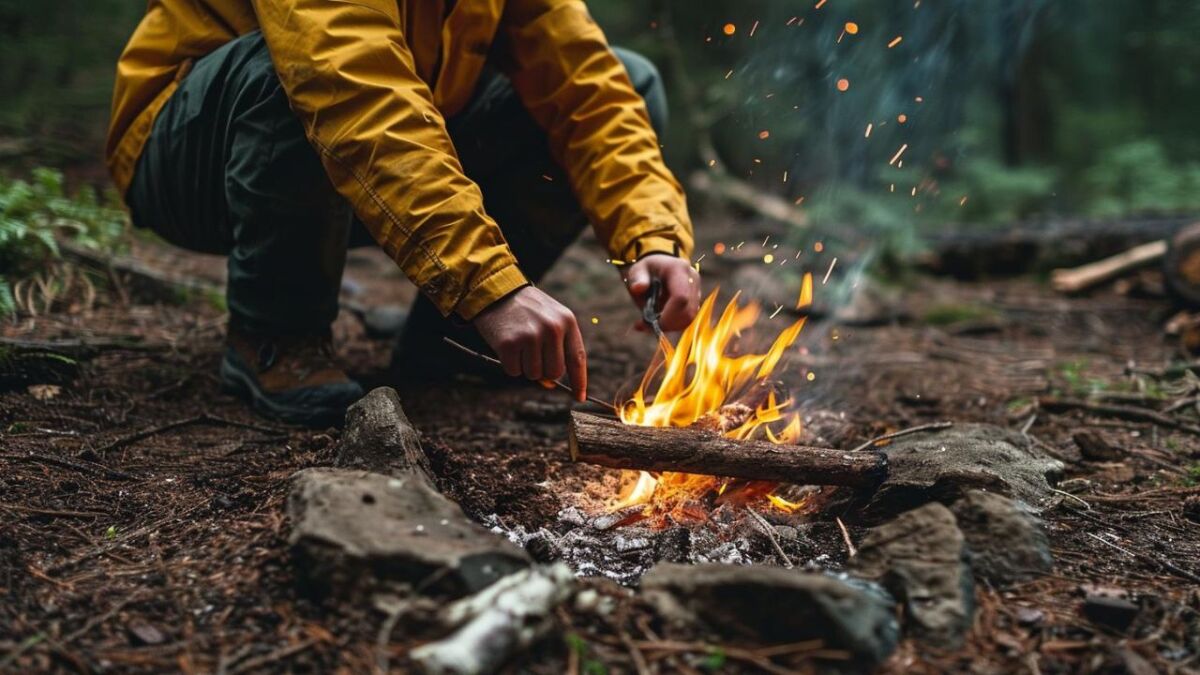
fire
Nomen
Meaning
Fire is a crucial element in the world of survival, bushcraft, and outdoor activities. It provides warmth, light, and the ability to cook food. In the wilderness, fire is a lifeline, offering comfort and security. It can be created using various methods, such as friction, flint and steel, or modern fire starters. Understanding fire safety and proper fire management is essential to prevent accidents and minimize environmental impact. Building and maintaining a fire requires knowledge of firewood selection, fire lay techniques, and fire extinguishing methods. Mastering fire skills is a fundamental aspect of outdoor living and self-reliance.

Examples
„I love spending time in the wilderness, practicing bushcraft and survival skills. One of the most essential skills is the ability to start a fire.“
„Imagine you're out in the woods, and it starts to get dark. You need to build a fire to keep warm and cook your food.“
„You gather some dry twigs, leaves, and a few pieces of birch bark to use as tinder. You carefully arrange them in a teepee shape, leaving enough space for air to circulate.“
„You take out your trusty fire starter, a ferro rod, and strike it against the back of your knife. Sparks fly, and the tinder catches fire. You blow gently, nurturing the flame until it grows bigger.“
„Soon, the fire is roaring, providing warmth and light. You sit by the fire, feeling a sense of accomplishment and security. You know that with fire, you have the ability to survive and thrive in the wilderness.“
Origin
The word "fire" originates from the Old English word "fȳr" and can be traced back to the Proto-Germanic word "fūr." It is believed to have its roots in the Proto-Indo-European word "péh₂wr̥," which means "to burn."
Fire has been an essential element for human survival and has played a significant role in our development as a species. It provided warmth, protection, and a means to cook food, which allowed early humans to expand their habitats and thrive in various environments.
Throughout history, fire has been used for various purposes, including hunting, signaling, and crafting tools. It has also held cultural and symbolic significance in many societies.
Over time, humans have learned to control and manipulate fire, developing techniques to start and maintain it. The discovery of fire-making methods, such as friction-based techniques like the bow drill or the use of flint and steel, revolutionized our ability to harness this powerful element.
In modern times, fire remains an essential tool in survival situations, camping, and bushcraft. It provides warmth, light, and the ability to cook food. Understanding fire safety, different fire-starting methods, and fire-building techniques is crucial for anyone venturing into the wilderness.
Synonyms
Blaze, Flame, Inferno, Conflagration, Combustion, Ignition, Incineration, Scorch
Antonyms
Water, Extinguish, Put out, Douse, Quench, Smother, Dampen, Suppress
Relatives
Campfire, Firewood, Firestarter, Fire pit, Fire safety, Fire building, Fire extinguisher, Fire making
Historical and cultural importance
Fire has a deep historical and cultural significance that spans across civilizations and time periods. It has been a vital element in human survival and has played a crucial role in shaping our development as a species.
From the earliest days of humanity, fire has provided warmth, light, and protection against predators. It allowed our ancestors to cook food, making it more digestible and reducing the risk of foodborne illnesses. The discovery of fire also enabled early humans to expand their habitats, as they could now venture into colder regions.
Fire has been a symbol of civilization and progress throughout history. It was used for forging tools and weapons, allowing humans to advance technologically. In ancient times, fire was associated with the divine and was used in religious ceremonies and rituals. It represented purification, transformation, and the power of creation.
Fire has also played a significant role in storytelling and mythology. It has been depicted as a force of destruction and renewal, capable of both bringing life and causing devastation. Many cultures have legends and folklore surrounding fire, with gods and heroes harnessing its power for various purposes.
In modern times, fire continues to hold cultural significance. It is a central element in celebrations and festivals around the world, such as bonfires during Midsummer or fireworks on New Year's Eve. Fire is also a symbol of warmth, comfort, and gathering, as people come together around campfires or fireplaces to share stories and connect with nature.
Overall, fire is not just a physical phenomenon but a symbol of human ingenuity, resilience, and our connection to the natural world. Its historical and cultural relevance helps us understand its importance in survival, technology, spirituality, and community.
More information about the term fire
Fire: The Essential Element for Survival
Fire is an essential element for survival in the wilderness. It provides warmth, light, and the ability to cook food. It can also be used to signal for help and ward off dangerous animals. In this article, we will explore the importance of fire in survival situations and discuss various methods of starting a fire in the wild.
The Importance of Fire
Fire is crucial for maintaining body temperature in cold environments. It provides warmth and helps prevent hypothermia, a potentially life-threatening condition. Additionally, fire provides light, which is essential for navigating in the dark and performing tasks at night.
Another vital aspect of fire is its ability to purify water. By boiling water over a fire, you can kill harmful bacteria and parasites, making it safe to drink. This is especially important when clean water sources are scarce or contaminated.
Fire also plays a significant role in cooking food. By roasting or boiling food over a fire, you can kill any bacteria or parasites present, making it safer to consume. Additionally, cooking food makes it easier to digest and increases its nutritional value.
Methods of Starting a Fire
There are several methods to start a fire in the wild, each with its own advantages and disadvantages. Here are a few commonly used techniques:
1. Friction-Based Methods: One of the oldest and most primitive methods is the friction-based method, such as using a bow drill or hand drill. These methods involve rubbing two pieces of wood together to create friction and generate enough heat to ignite a fire.
2. Ferrocerium Rod: A ferrocerium rod, also known as a fire starter or firesteel, is a popular and reliable tool for starting fires. It consists of a rod made of a ferrocerium alloy that produces sparks when struck with a hard object, such as a knife or rock.
3. Solar Ignition: In sunny conditions, you can use the power of the sun to start a fire. By focusing sunlight onto a small area using a magnifying glass or a piece of curved glass, you can create enough heat to ignite dry tinder.
4. Fire Plow: The fire plow method involves using a wooden plank and a stick to create friction and generate an ember. By rapidly rubbing the stick back and forth along the groove of the plank, you can create enough heat to ignite the tinder.
Conclusion
Fire is an essential element for survival in the wilderness. It provides warmth, light, and the ability to cook food and purify water. Knowing how to start a fire using various methods is a crucial skill for any outdoor enthusiast or survivalist. Remember to always prioritize safety and be mindful of your surroundings when starting a fire in the wild.
Back to overview

